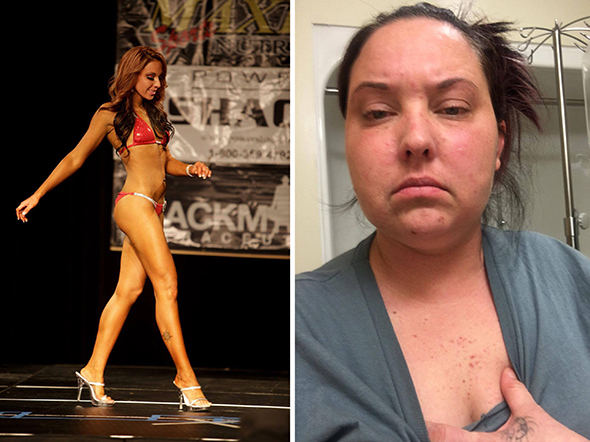A former bikini model’s weight gain was the main clue to her cancer and Cushings disease discoveries.

Victoria Perez was a former bikini model, fitness enthusiast, medical student, and single mom to a beautiful 4-year-old son when her health started to decline quickly with no discernible cause. It began years before with simple fatigue.
“I remember being tired all the time. I think over three years I realized I was more tired than the average 29-year-old. I would drink Red Bulls non-stop and pop caffeine pills just to stay awake.”
In October 2015, Victoria’s second symptom began to appear in the form of rapid weight gain, especially in her midsection. She chalked it up to her metabolism and age, and started running in the mornings to try and maintain her 130-pound figure.
What she didn’t know was that she actually suffered from Cushing’s disease, a syndrome that occurs when the body is exposed too much of the hormone cortisol. She didn’t realize that working out was actually exacerbating her problem.
By the end of January 2016, Victoria had a bad case of bronchitis and began having stomach issues. Her midsection was swollen all the time, and she was constipated so much that she had to drink 2-3 laxative teas every day just to have a bowel movement.
Doctors chalked this change up to IBS, which is a common problem in women—especially stressed single moms. She then developed an itchy rash on her hands, which got so bad within a span of four days that she woke up bloody, having clawed at herself in her sleep.
She went to the ER, and was prescribed steroids, but they couldn’t find anything wrong. Unfortunately, the steroids sent her pituitary gland into fight or flight mode, and created an excessive amount of cortisol.
READ MORE: Teen with Cancer Inspires Others with a Photoshoot
All this time, she was hitting the gym and adding muscle, but her body was already dealing with an excess of cortisol (the body’s natural steroid), so exercising was only making it worse. What followed was a series of frustrating appointments with doctors who weren’t communicating with each other, and who tried treating her symptoms of swelling, bloating, and fatigue instead of looking for a larger issue.
They kept telling her that it was nothing to worry about, but she started to wonder if something was really wrong.
By March, Victoria was at 155 pounds, which was ten more pounds than than the day she delivered her son. She was at the gym again, doing cable row exercises when she noticed a huge hump on the back of her neck. She asked another gym-goer what it was and quickly went to visit her primary doctor.
“She looked at me and told me ‘this is Cushings disease.’ I looked at her and said what’s that? I mean dogs and cats get this, not humans, right? She said ‘This is above my pay grade and I am going to send you to an endocrinologist.'” So she did.
Victoria was again sent to another doctor, who confirmed in April 2016 that she had Cushings disease. They diagnosed her by doing an IPSS test, wherein they stuck stents through her groin into her brain to release dyes. She was told that the treatment was extensive, and was going to take time.
“I remember them telling me this is going to be a long lengthy process, I thought I don’t have a lengthy time! I feel like I’m swelling up like a balloon.”
Victoria says by this point she felt like a stranger in her own body, and every doctor seemed to be telling her something different. Primary doctors, allergists, endocrinologists, and ER doctors were all saying something different and trying to treat her symptoms, but all her symptoms were just getting worse.
She was referred to the University of Alabama in Birmingham, but was told they couldn’t see her for many months.
“I broke down in tears in my bathroom and told my mom I can’t do this anymore! I am going to die! I know it!”
Her mother rushed her to UAB, and thankfully, they were able to fit her in for an MRI and scan, but then sent her home. Weeks passed, and her symptoms continued to develop. At her lowest point, her potassium was below a level 1, which can be fatal, and lead to a two-day hospitalization.
She also spent another two days for blood pressure at 210/190, which is high enough to cause a stroke.
“By now I looked like a swollen balloon. My feet where holding so much fluid they looked like they where about to explode. I couldn’t leave my house. I was dizzy and tired and sick all the time. I couldn’t even wear shoes.”
She was then told the news that nobody ever wants to hear. She had a brain tumor and all the other doctors had missed it. This development sent Victoria into another spiral, made worse by the fact that her insurance began to deny her claims. Her primary doctor began to get frustrated with her, and deny her requests for bloodwork.
She returned to UAB for more tests and procedures, and was finally cleared for surgery. She then found out she had Diabetes Insidious, and needed insulin shots every hour. This lead to another MRI which revealed a second tumor.
“The neurologist took my MRI and I was on the ultrasound table when she came in and said Victoria, we found it. There’s another tumor in your brain. I cried! I cried because I was scared! How could they miss this? What if I die this time? She said ‘We’re going in aggressively, and we are going to remove your entire pituitary gland.’”
The surgery was quickly scheduled and performed, but the struggle continued to be real, and she experienced pneumonia, fluid in both lungs, and had to have blood transfusions and hourly insulin and monitoring. Throughout the process, Victoria also suffered socially. She went through bouts of depression and found no real support from her fitness community.
“I was cyber bullied after three months from a group of fitness people locally in this area which sent me into a huge depression. I didn’t want to leave my house. I felt ugly and even hated myself. I was ashamed of myself and I didn’t even know who I was. I cried and avoided mirrors. I had always been healthy and fit and these people where making fun of my weight gain and my disease.”
Her son also felt the consequences of her disease.
“He was acting out in school, saying hurtful things he even told me he wish he was never born. It killed me! But it made me get stronger and healthier faster! I pushed myself 100,000 times harder than most Cushings disease recoveries because I am all he has!”
She finally left the hospital July 12th, 2016, thankful that she finally got the correct information and treatment.
Since then Victoria has lost 26 pounds, and currently weighs 146 pounds. She was wheelchair-bound for a month and had to learn to walk again, and will likely remain on medication for the rest of her life. She carries an injectable steroid on her in case she goes into adrenal crisis.
Beyond the hospital stays, the tests, and the high levels of stress and anxiety, she says the worst part was the frustration of not knowing what was happening to her body, and getting no real answers from the doctors, who are supposed to be experts in their fields.
Most Cushings disease patients see a resurgence of the syndrome and require further surgeries, so Victoria’s main goal in life is to spread awareness about the disease, and encourage people who are experiencing the symptoms to get tested.

Victoria Perez today, working to get back into shape.
Victoria has set up a gofundme to help with medical expenses. Click HERE to help out.
Love this article? For more beauty, style, travel, and trending topics check out The Luxury Spot on Facebook. Like us and we’ll love you back!















As an advocate for the Cushing’s community, I am pleased to see Vicki’s story making the news. As anyone with a rare disease knows, educating the public and sometimes the medical community is a vital step in raising awareness and getting more patients diagnosed and treated. However, we are also very cautious to promote only facts about the disease. This article has a few errors that I think need to be noted. The title of the article is not accurate, as Vicki’s tumor was a skull base tumor as the pituitary lies at the base of the brain and behind the bridge of the nose. ‘Brain tumor’ is accepted terminology as it requires surgical intervention by a neurologist, but it differs from other brain tumors that invade the gray matter. Vicki’s tumor was not cancer. Almost all Cushing’s tumors are benign (free of malignancy) although they certainly do cause harm to the body. A very rare subset of Cushing’s tumors found in the adrenal gland or somewhere else in the body are carcinoids but fortunately Vicki did not have this type. Tumor removal is the treatment of choice, with follow-on radiation in very, very few cases. Chemotherapy is not required. Another error in the article concerned Vicki’s Diabetes Insipidus. This is an imbalance of water in the body and is not related in any way to Diabetes Type I or Type II. The disorder is treated with DDVAP, a medication that normalizes urine output. Insulin injections would not be a line of treatment for the condition. Finally, while reoccurrence is a possibility to always be aware of, many patients get full remission from a single pituitary surgery.
Cushing’s disease is often thought of as ‘too rare’ to be on a doctor’s radar. However, more recent studies and anecdotal experiences suggest that the disease might be underdiagnosed or misdiagnosed as PCOS, psychological impairment, or brought on by lifestyle choices. It is important to be your own medical advocate and insist on continued testing if you have symptoms like Vicki’s, because in the final analysis, Cushing’s can kill.